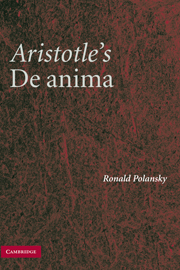Book contents
- Frontmatter
- Contents
- Preface
- List of Abbreviations
- Introduction
- COMMENTARY ON DE ANIMA: : Book 1
- COMMENTARY ON DE ANIMA: Book 2
- 1 Definition of Soul
- 2 What Is Life?
- 3 How Powers of Soul Are Distributed and United in the Soul
- 4 The Nutritive Faculty: Its Object and Subfaculties
- 5 Clarification of Being Affected, Living as Saving, and the First Definition of Sense
- 6 The Three Sorts of Sensible Objects
- 7 Vision, Medium, and Object
- 8 Hearing, Sound, and Voice
- 9 Smell and Odor
- 10 Taste Is a Contact Sense; the Tasteable
- 11 Touch, the Tangibles, and Sense as a Mean
- 12 Definition of Sense and Whether Sensibles Affect Nonperceiving Bodies
- COMMENTARY ON DE ANIMA: Book 3
- Bibliography
- Index
11 - Touch, the Tangibles, and Sense as a Mean
Published online by Cambridge University Press: 18 December 2009
- Frontmatter
- Contents
- Preface
- List of Abbreviations
- Introduction
- COMMENTARY ON DE ANIMA: : Book 1
- COMMENTARY ON DE ANIMA: Book 2
- 1 Definition of Soul
- 2 What Is Life?
- 3 How Powers of Soul Are Distributed and United in the Soul
- 4 The Nutritive Faculty: Its Object and Subfaculties
- 5 Clarification of Being Affected, Living as Saving, and the First Definition of Sense
- 6 The Three Sorts of Sensible Objects
- 7 Vision, Medium, and Object
- 8 Hearing, Sound, and Voice
- 9 Smell and Odor
- 10 Taste Is a Contact Sense; the Tasteable
- 11 Touch, the Tangibles, and Sense as a Mean
- 12 Definition of Sense and Whether Sensibles Affect Nonperceiving Bodies
- COMMENTARY ON DE ANIMA: Book 3
- Bibliography
- Index
Summary
The treatment of touch completes the accounts of the five senses. The sense of touch presents a peculiar problem inasmuch as there is not a simple set of proper sensible objects, as there is merely color for sight or flavor for taste. Taste has a single contrariety, sweet-bitter, and sight the single contrariety white-black, which covers the entire range of types of sensibles. The tangible objects include several such contrarieties: hot-cold, wet-dry, hard-soft, and so on. Consequently, it is unclear whether there can be a single sense and sense organ for touch, as well as whether touch involves a medium at all, since it is a contact sense, and whether there can be but one medium for touch. Finally, it seems that the sensory apparatus in touch undergoes standard rather than nonstandard alterations. The flesh may surely be heated, cooled, dried, or moistened by the sensible objects that we feel, and perhaps when we touch something hard the compression hardens the flesh while touching the soft relaxes and softens the flesh. Touch may, because of such standard alterations, run afoul of the general account of perception in 418a3–6. If Aristotle can show that touch requires a single medium and sense organ, and that nonstandard alteration occurs regarding these, then he confirms the line he has taken throughout his earlier treatments. Since touch is the most necessary and fundamental sense, proof that it conforms to what is anticipated from the earlier accounts solidifies the entire Aristotelian framework.
- Type
- Chapter
- Information
- Aristotle's De AnimaA Critical Commentary, pp. 321 - 337Publisher: Cambridge University PressPrint publication year: 2007



